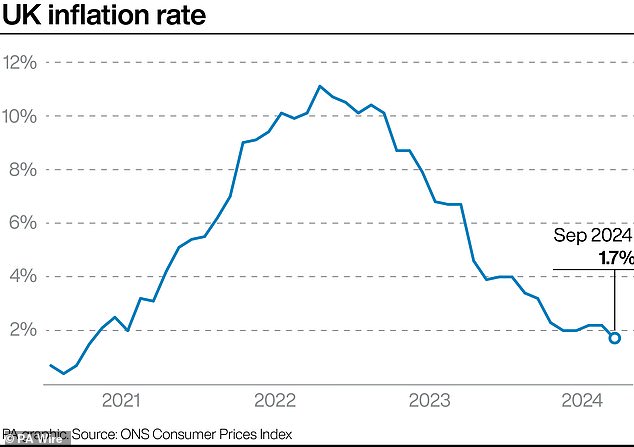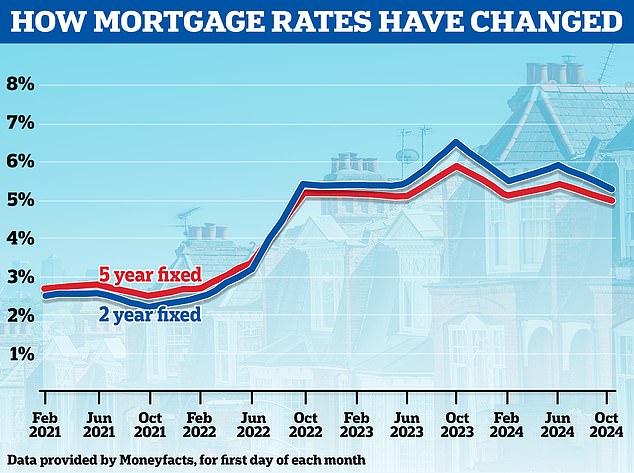Barclays and Halifax are raising mortgage rates: here’s why they’re rising
Two more major banks have announced that they will increase mortgage rates.
Barclays and Halifax say they will increase rates on several home loans from tomorrow.
It follows an upward move from NatWest today and rate hikes from Santander and TSB earlier this week.
It looks like many of Barclays’ fixed rate deals will rise by 0.2 percentage points.
Positive: five major lenders increased mortgage rates this week
Barclays currently has the second lowest five-year fix on the market for buyers purchasing with at least a 40 percent deposit. Starting tomorrow, that deal will increase to 3.96 percent.
For a mortgage of €200 that is repaid over a period of 25 years, this is the difference between €1,029 per month and €1,051 per month.
Barclays’ market-leading deal of 3.85 per cent for those who buy with a 25 per cent deposit will also rise to 4.05 per cent from tomorrow.
Homebuyers with a 10 per cent deposit could also lose out if Barclays increases the interest rate on its Best Buy 4.39 per cent to 4.59 per cent.
Fixes for two years are also in the line of fire. Barclays increases the interest rate on the lowest two-year interest rate from 3.9 percent to 4.1 percent.
This leaves only Santander and Nationwide offering two-year fixes below 4 percent.
For homebuyers buying with a 15 per cent deposit they will see the leading market Barclays rate increase by 4.4 per cent to 4.6 per cent tomorrow.
Shortly after news broke that Barclays would raise rates, Halifax followed suit.
The lender announced interest rate increases on two- and five-year fixed-rate products from tomorrow, of between 0.11 and 0.24 percentage points.
This is expected to lead to the disappearance of more deals below 4 percent.
Why are mortgage rates rising?
Mortgage interest rates have fallen at a considerable pace since the summer.
Between early July and the end of last week, the cheapest available five-year fixed-rate mortgage fell from 4.28 percent to 3.68 percent.
Meanwhile, the lowest two-year interest rate fell from 4.68 percent to 3.84 percent.
However, they are now creeping up again.
Lenders were expected to raise rates this week as the Sonia swap rate – an interbank rate based on future interest rate expectations – has moved higher in recent weeks.
When the Sonia swaps rise enough, this often results in a rise in the fixed mortgage rate, and vice versa when it falls.
On October 14, five-year swaps were 3.8 percent and two-year swaps were 4.02 percent.
This was higher than a month earlier, when five-year swaps were 3.39 percent and two-year swaps were 3.73 percent.
The increase in swaps means there is little to no margin for lenders to make money, which is why some have to raise their prices.
However, yesterday the ONS showed inflation fell to 1.7 per cent in the 12 months to September, down from 2.2 per cent in August.
This was the first time since April 2021 that inflation fell below target and was below market forecasts of 1.9 percent.
Some experts believe this increases the chances that the Bank of England will accelerate the pace of interest rate cuts.

Inflation monitoring: Inflation has fallen to 1.7%, the lowest level in more than three years
As a result, Sonia swaps have since fallen again, according to Mark Harris, CEO of mortgage broker SPF Private Clients.
However, lenders are still likely to temporarily hike prices upward to avoid attracting too many customers at rates they can’t currently monetize.
“After a good run of falling mortgage rates, a number of lenders have increased prices due to higher swap rates,” Harris says.
‘The latter have risen on budget speculation and concerns about the Middle East, but since better-than-expected inflation news and growing expectations that interest rates will be cut again this year, swaps have fallen again.
‘Lenders who have not been able to absorb the increase in swaps have had to increase their mortgage interest rates.’
‘This has led to increased business from lenders who have not adjusted their prices and therefore offered market leading products.
“As volumes increase, service delivery could suffer. As a result, some lenders have adjusted their prices to slow the volume of incoming business. This domino effect will continue until costs or volumes dictate a reversal.”
Harris therefore thinks that more lenders such as Nationwide and HSBC are likely to increase their interest rates in the coming days or weeks.

We’re going up again: Mortgage providers have been cutting interest rates in recent months, but this week there’s been a reversal in that trend
How long do mortgage providers have to fix themselves?
Harris expects interest rates to continue to fall in the long term and says many borrowers are currently opting for the shorter two-year fixed rate period, based on the assumption that interest rates will be lower in two years.
“In the short term we expect further price revisions upwards, but in the longer term the direction of travel appears to be downwards,” he says.
“Borrowers should plan ahead and speak to a market-wide broker. You can usually reserve rates up to six months before you need them; If the mortgage interest rate has dropped when you come to close, your broker should switch you to a cheaper product.
‘We notice that many customers opt for products with a shorter term, in the hope that the rates will be lower when they refinance.’
However, Rachael Hunnisett, director of longer-term mortgage lender April Mortgages, believes borrowers could become disappointed if they lock in their mortgage for two years.
She believes the era of 1 to 2 percent mortgage rates is over and says it is important for borrowers to think carefully about taking a fixed short-term rate.
“The increase in interest rates underlines the discrepancy between expectations about base rates and mortgage rates,” Hunnisett said.
‘Over the past 24 months, the mortgage market has experienced significant interest rate movements, and mortgage rates, typically based on swap rates that take into account future market forecasts, remain volatile.
‘Borrowers should carefully assess their risk tolerance and consider whether they can withstand a significant interest rate shock if rates continue to rise, especially when choosing how long to lock in their mortgage.
“Speculating on future mortgage interest rates, especially with what is often the largest financial obligation of your life: your mortgage, is a high-risk strategy. There are no indications that those low rates will return anytime soon.”
Some links in this article may be affiliate links. If you click on it, we may earn a small commission. That helps us fund This Is Money and keep it free to use. We do not write articles to promote products. We do not allow a commercial relationship to compromise our editorial independence.
